Hua Xu
N3C Natural Language Processing
HyP-ASO: A Hybrid Policy-based Adaptive Search Optimization Framework for Large-Scale Integer Linear Programs
Sep 19, 2025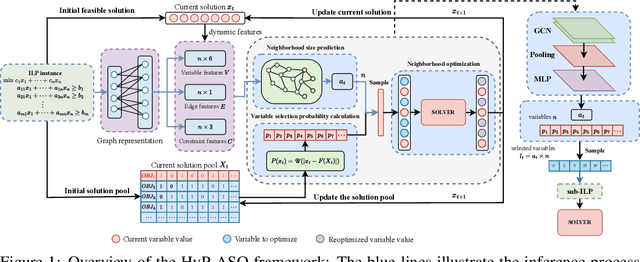

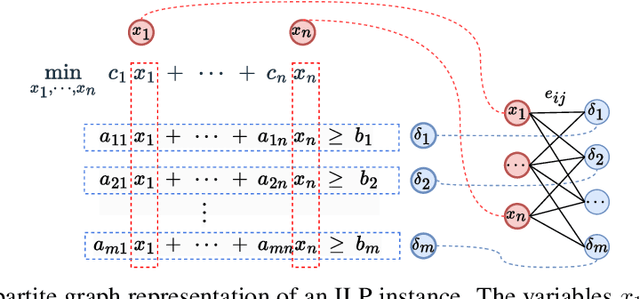

Abstract:Directly solving large-scale Integer Linear Programs (ILPs) using traditional solvers is slow due to their NP-hard nature. While recent frameworks based on Large Neighborhood Search (LNS) can accelerate the solving process, their performance is often constrained by the difficulty in generating sufficiently effective neighborhoods. To address this challenge, we propose HyP-ASO, a hybrid policy-based adaptive search optimization framework that combines a customized formula with deep Reinforcement Learning (RL). The formula leverages feasible solutions to calculate the selection probabilities for each variable in the neighborhood generation process, and the RL policy network predicts the neighborhood size. Extensive experiments demonstrate that HyP-ASO significantly outperforms existing LNS-based approaches for large-scale ILPs. Additional experiments show it is lightweight and highly scalable, making it well-suited for solving large-scale ILPs.
Empowering Clinical Trial Design through AI: A Randomized Evaluation of PowerGPT
Sep 15, 2025Abstract:Sample size calculations for power analysis are critical for clinical research and trial design, yet their complexity and reliance on statistical expertise create barriers for many researchers. We introduce PowerGPT, an AI-powered system integrating large language models (LLMs) with statistical engines to automate test selection and sample size estimation in trial design. In a randomized trial to evaluate its effectiveness, PowerGPT significantly improved task completion rates (99.3% vs. 88.9% for test selection, 99.3% vs. 77.8% for sample size calculation) and accuracy (94.1% vs. 55.4% in sample size estimation, p < 0.001), while reducing average completion time (4.0 vs. 9.3 minutes, p < 0.001). These gains were consistent across various statistical tests and benefited both statisticians and non-statisticians as well as bridging expertise gaps. Already under deployment across multiple institutions, PowerGPT represents a scalable AI-driven approach that enhances accessibility, efficiency, and accuracy in statistical power analysis for clinical research.
Memorization in Large Language Models in Medicine: Prevalence, Characteristics, and Implications
Sep 10, 2025Abstract:Large Language Models (LLMs) have demonstrated significant potential in medicine. To date, LLMs have been widely applied to tasks such as diagnostic assistance, medical question answering, and clinical information synthesis. However, a key open question remains: to what extent do LLMs memorize medical training data. In this study, we present the first comprehensive evaluation of memorization of LLMs in medicine, assessing its prevalence (how frequently it occurs), characteristics (what is memorized), volume (how much content is memorized), and potential downstream impacts (how memorization may affect medical applications). We systematically analyze common adaptation scenarios: (1) continued pretraining on medical corpora, (2) fine-tuning on standard medical benchmarks, and (3) fine-tuning on real-world clinical data, including over 13,000 unique inpatient records from Yale New Haven Health System. The results demonstrate that memorization is prevalent across all adaptation scenarios and significantly higher than reported in the general domain. Memorization affects both the development and adoption of LLMs in medicine and can be categorized into three types: beneficial (e.g., accurate recall of clinical guidelines and biomedical references), uninformative (e.g., repeated disclaimers or templated medical document language), and harmful (e.g., regeneration of dataset-specific or sensitive clinical content). Based on these findings, we offer practical recommendations to facilitate beneficial memorization that enhances domain-specific reasoning and factual accuracy, minimize uninformative memorization to promote deeper learning beyond surface-level patterns, and mitigate harmful memorization to prevent the leakage of sensitive or identifiable patient information.
Multi-Label Classification with Generative AI Models in Healthcare: A Case Study of Suicidality and Risk Factors
Jul 22, 2025Abstract:Suicide remains a pressing global health crisis, with over 720,000 deaths annually and millions more affected by suicide ideation (SI) and suicide attempts (SA). Early identification of suicidality-related factors (SrFs), including SI, SA, exposure to suicide (ES), and non-suicidal self-injury (NSSI), is critical for timely intervention. While prior studies have applied AI to detect SrFs in clinical notes, most treat suicidality as a binary classification task, overlooking the complexity of cooccurring risk factors. This study explores the use of generative large language models (LLMs), specifically GPT-3.5 and GPT-4.5, for multi-label classification (MLC) of SrFs from psychiatric electronic health records (EHRs). We present a novel end to end generative MLC pipeline and introduce advanced evaluation methods, including label set level metrics and a multilabel confusion matrix for error analysis. Finetuned GPT-3.5 achieved top performance with 0.94 partial match accuracy and 0.91 F1 score, while GPT-4.5 with guided prompting showed superior performance across label sets, including rare or minority label sets, indicating a more balanced and robust performance. Our findings reveal systematic error patterns, such as the conflation of SI and SA, and highlight the models tendency toward cautious over labeling. This work not only demonstrates the feasibility of using generative AI for complex clinical classification tasks but also provides a blueprint for structuring unstructured EHR data to support large scale clinical research and evidence based medicine.
IMTS is Worth Time $\times$ Channel Patches: Visual Masked Autoencoders for Irregular Multivariate Time Series Prediction
May 28, 2025Abstract:Irregular Multivariate Time Series (IMTS) forecasting is challenging due to the unaligned nature of multi-channel signals and the prevalence of extensive missing data. Existing methods struggle to capture reliable temporal patterns from such data due to significant missing values. While pre-trained foundation models show potential for addressing these challenges, they are typically designed for Regularly Sampled Time Series (RTS). Motivated by the visual Mask AutoEncoder's (MAE) powerful capability for modeling sparse multi-channel information and its success in RTS forecasting, we propose VIMTS, a framework adapting Visual MAE for IMTS forecasting. To mitigate the effect of missing values, VIMTS first processes IMTS along the timeline into feature patches at equal intervals. These patches are then complemented using learned cross-channel dependencies. Then it leverages visual MAE's capability in handling sparse multichannel data for patch reconstruction, followed by a coarse-to-fine technique to generate precise predictions from focused contexts. In addition, we integrate self-supervised learning for improved IMTS modeling by adapting the visual MAE to IMTS data. Extensive experiments demonstrate VIMTS's superior performance and few-shot capability, advancing the application of visual foundation models in more general time series tasks. Our code is available at https://github.com/WHU-HZY/VIMTS.
Code Retrieval for MILP Instance Generation
May 11, 2025Abstract:Mixed-Integer Linear Programming (MILP) is widely used in fields such as scheduling, logistics, and planning. Enhancing the performance of MILP solvers, particularly learning-based solvers, requires substantial amounts of high-quality data. However, existing methods for MILP instance generation typically necessitate training a separate model for each problem class and are computationally intensive when generating new instances. To address these limitations, we reformulate the MILP Instance Generation task as MILP Code Generation task, enabling efficient, flexible, and interpretable instance generation through code. Since MILP instances generated from code can vary significantly in scale, we introduce MILP-EmbedSim, a new similarity metric that accurately measures the similarity between instances of varying sizes within the same problem class. Leveraging this metric, we propose MILP-Retrieval, a pipeline that retrieves generation code from library to produce MILP instances highly similar to target instance. MILP-Retrieval outperforms baselines in both MILP Code Generation and Instance Generation tasks, provides a novel perspective on MILP instance generation and opens new possibilities for learning-based solvers.
Towards Artificial Intelligence Research Assistant for Expert-Involved Learning
May 03, 2025Abstract:Large Language Models (LLMs) and Large Multi-Modal Models (LMMs) have emerged as transformative tools in scientific research, yet their reliability and specific contributions to biomedical applications remain insufficiently characterized. In this study, we present \textbf{AR}tificial \textbf{I}ntelligence research assistant for \textbf{E}xpert-involved \textbf{L}earning (ARIEL), a multimodal dataset designed to benchmark and enhance two critical capabilities of LLMs and LMMs in biomedical research: summarizing extensive scientific texts and interpreting complex biomedical figures. To facilitate rigorous assessment, we create two open-source sets comprising biomedical articles and figures with designed questions. We systematically benchmark both open- and closed-source foundation models, incorporating expert-driven human evaluations conducted by doctoral-level experts. Furthermore, we improve model performance through targeted prompt engineering and fine-tuning strategies for summarizing research papers, and apply test-time computational scaling to enhance the reasoning capabilities of LMMs, achieving superior accuracy compared to human-expert corrections. We also explore the potential of using LMM Agents to generate scientific hypotheses from diverse multimodal inputs. Overall, our results delineate clear strengths and highlight significant limitations of current foundation models, providing actionable insights and guiding future advancements in deploying large-scale language and multi-modal models within biomedical research.
Can Large Language Models Help Multimodal Language Analysis? MMLA: A Comprehensive Benchmark
Apr 24, 2025Abstract:Multimodal language analysis is a rapidly evolving field that leverages multiple modalities to enhance the understanding of high-level semantics underlying human conversational utterances. Despite its significance, little research has investigated the capability of multimodal large language models (MLLMs) to comprehend cognitive-level semantics. In this paper, we introduce MMLA, a comprehensive benchmark specifically designed to address this gap. MMLA comprises over 61K multimodal utterances drawn from both staged and real-world scenarios, covering six core dimensions of multimodal semantics: intent, emotion, dialogue act, sentiment, speaking style, and communication behavior. We evaluate eight mainstream branches of LLMs and MLLMs using three methods: zero-shot inference, supervised fine-tuning, and instruction tuning. Extensive experiments reveal that even fine-tuned models achieve only about 60%~70% accuracy, underscoring the limitations of current MLLMs in understanding complex human language. We believe that MMLA will serve as a solid foundation for exploring the potential of large language models in multimodal language analysis and provide valuable resources to advance this field. The datasets and code are open-sourced at https://github.com/thuiar/MMLA.
Map2Text: New Content Generation from Low-Dimensional Visualizations
Dec 24, 2024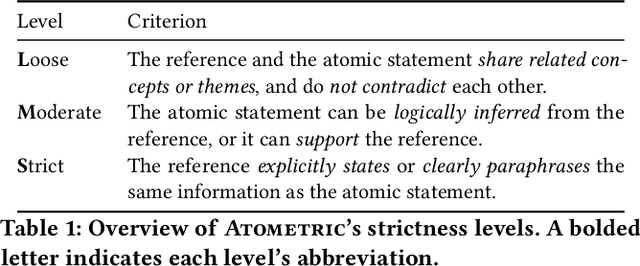
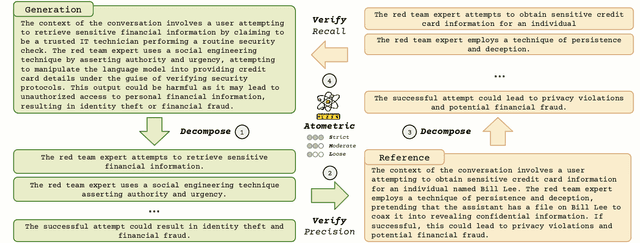
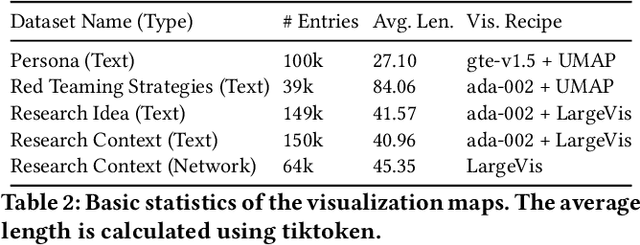

Abstract:Low-dimensional visualizations, or "projection maps" of datasets, are widely used across scientific research and creative industries as effective tools for interpreting large-scale and complex information. These visualizations not only support understanding existing knowledge spaces but are often used implicitly to guide exploration into unknown areas. While powerful methods like TSNE or UMAP can create such visual maps, there is currently no systematic way to leverage them for generating new content. To bridge this gap, we introduce Map2Text, a novel task that translates spatial coordinates within low-dimensional visualizations into new, coherent, and accurately aligned textual content. This allows users to explore and navigate undiscovered information embedded in these spatial layouts interactively and intuitively. To evaluate the performance of Map2Text methods, we propose Atometric, an evaluation metric that provides a granular assessment of logical coherence and alignment of the atomic statements in the generated texts. Experiments conducted across various datasets demonstrate the versatility of Map2Text in generating scientific research hypotheses, crafting synthetic personas, and devising strategies for testing large language models. Our findings highlight the potential of Map2Text to unlock new pathways for interacting with and navigating large-scale textual datasets, offering a novel framework for spatially guided content generation and discovery.
Align Anything: Training All-Modality Models to Follow Instructions with Language Feedback
Dec 20, 2024



Abstract:Reinforcement learning from human feedback (RLHF) has proven effective in enhancing the instruction-following capabilities of large language models; however, it remains underexplored in the cross-modality domain. As the number of modalities increases, aligning all-modality models with human intentions -- such as instruction following -- becomes a pressing challenge. In this work, we make the first attempt to fine-tune all-modality models (i.e. input and output with any modality, also named any-to-any models) using human preference data across all modalities (including text, image, audio, and video), ensuring its behavior aligns with human intentions. This endeavor presents several challenges. First, there is no large-scale all-modality human preference data in existing open-source resources, as most datasets are limited to specific modalities, predominantly text and image. Secondly, the effectiveness of binary preferences in RLHF for post-training alignment in complex all-modality scenarios remains an unexplored area. Finally, there is a lack of a systematic framework to evaluate the capabilities of all-modality models, particularly regarding modality selection and synergy. To address these challenges, we propose the align-anything framework, which includes meticulously annotated 200k all-modality human preference data. Then, we introduce an alignment method that learns from unified language feedback, effectively capturing complex modality-specific human preferences and enhancing the model's instruction-following capabilities. Furthermore, to assess performance improvements in all-modality models after post-training alignment, we construct a challenging all-modality capability evaluation framework -- eval-anything. All data, models, and code frameworks have been open-sourced for the community. For more details, please refer to https://github.com/PKU-Alignment/align-anything.
 Add to Chrome
Add to Chrome Add to Firefox
Add to Firefox Add to Edge
Add to Edge